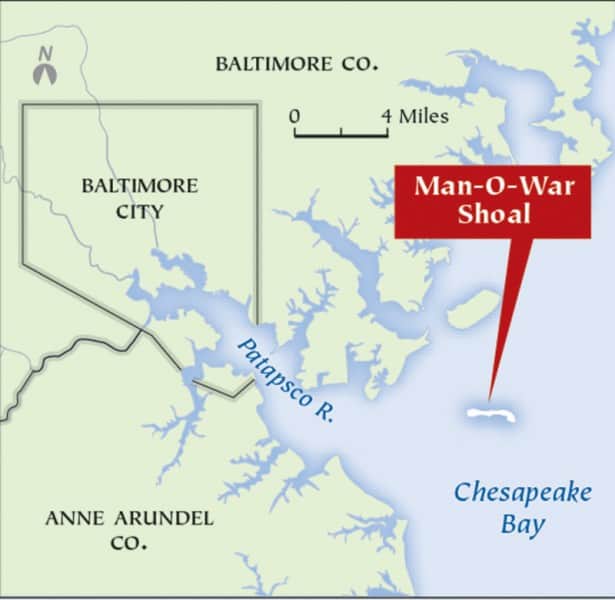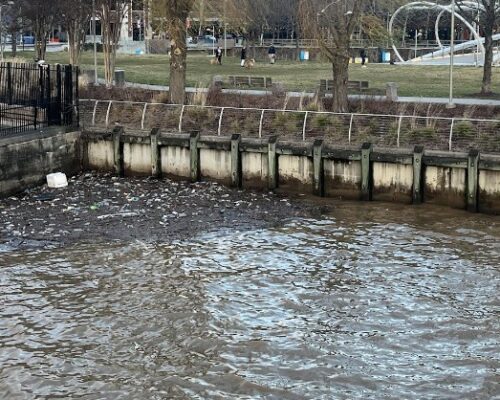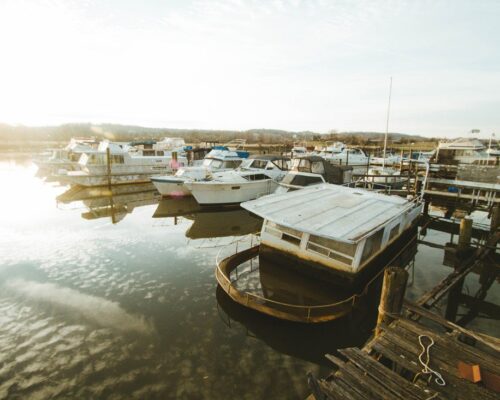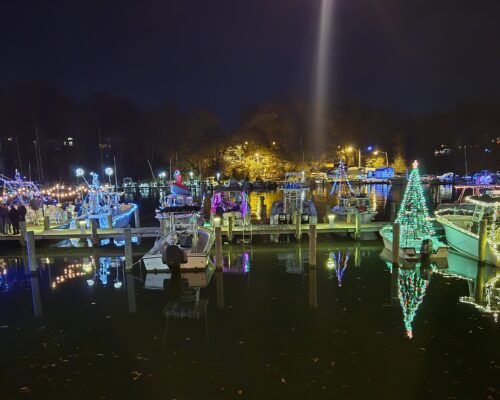By Timothy Wheeler, Bay Journal News Service
The Hogan administration is pressing ahead with its bid to dredge old oyster shells from the largest remaining deposit in Maryland’s portion of the Chesapeake Bay — a move backed by watermen but widely opposed by conservationists and recreational anglers.
The state Department of the Environment has declared its support for the plan to mine 5 million bushels of shells from Man-O-War Shoals, near the mouth of the Patapsco River. The MDE issued a public notice Nov. 1 recommending that the state Board of Public Works grant the Department of Natural Resources a tidal wetlands license, which is needed to do the dredging.
bayjournal.comThe plan still needs federal approval, but if given the green light, DNR officials say the old shells would be used to replenish reefs in waters open to commercial harvest, help private oyster growers and restore reefs in sanctuary areas.
Man-O-War Shoals is an ancient reef rising from the Bay bottom near Baltimore, estimated to harbor up to 100 million bushels of shells in its 456-acre footprint. Though productive long ago, it has very few live oysters now, despite repeated efforts to reseed it.
Oyster shells are generally thought to be the best substrate, or hard surface, for attracting baby oyster spat and enabling them to grow. Watermen and DNR officials say the cache in Man-O-War is needed to help rebuild the Bay’s lost oyster habitat and sustain the traditional wild harvest.
But anglers say Man-O-War is one of the best fishing spots in the Upper Chesapeake for white perch and striped bass, and contend that dredging could ruin it. Conservationists also object to disrupting the rich underwater habitat, and point out that there are other materials that could be used to rebuild the Bay’s oyster habitat, which DNR estimates has declined by nearly 70 percent in the past 40 years alone.
Since the wild harvest plummeted decades ago, oyster shell has become expensive and difficult to obtain. With Maryland, Virginia and the federal government committed to large-scale restoration efforts, officials have been forced to try alternative sources, such as Florida fossil shell and, more recently, clam shells from New Jersey. Both have been used in large-scale restoration projects on the Eastern Shore, including Harris Creek, the Little Choptank River and Tred Avon River.
The restoration work is finished in Harris Creek but continuing in the Little Choptank and Tred Avon. Scientists say the alternatives have proven suitable, with granite reefs in Harris Creek garnering much higher spat counts than nearby reefs covered with clam shells. The cost of acquiring granite stone is roughly on par with estimates the DNR has made for dredging up the old oyster shells.
Watermen have objected, though, to the use of materials other than shells in the restoration projects, complaining they disrupt crabbing, among other things. They have won the Hogan administration’s support in blocking further use of alternate substrate in reef construction in the Tred Avon and Little Choptank.
Public comments are being taken through Nov. 21 on the MDE’s recommendation to approve the license, with possible action some time in December. The Board of Public Works, made up of Gov. Larry Hogan, Comptroller Peter Franchot and Treasurer Nancy Kopp, must approve dredging and other activities that would affect state waters and wetlands.
Even if the board grants the license, the project still must win approval from the U.S. Army Corps of Engineers, which must decide whether to grant a permit to dredge. The DNR originally applied for a permit years ago, without success, and reapplied in 2015. The state’s application has been revised and tweaked since in response to queries from federal regulators.
A decision on the DNR’s permit application could be forthcoming sometime this winter, said Sarah Gross, spokeswoman for the Corps’ Baltimore District.
The Corps hasn’t said if it will grant the DNR a dredging permit, but earlier this year federal regulators suggested that if they were to do so, they would impose several conditions on the project. DNR officials have agreed to all of the conditions.
“It shouldn’t take as long as it does to settle this one way or the other,” complained Robert T. Brown Sr., president of the Maryland Watermen’s Association.
As proposed now, the DNR plans to dredge shells from Man-o-War in two installments, of 2 million and 3 million bushels, over a five-year period. There would be water-quality and fish monitoring before and after the first installment.
The DNR has declined to specify in advance how it would distribute the shells among competing uses, though it has suggested as much as 90 percent could go to restore sanctuary reefs or up to 75 percent could be placed in waters where oysters could be harvested.
Brown said it’s premature to talk about how the shell would be used, but did say he thought it would be wasted to put it all into restoring reefs in sanctuaries.
DNR officials estimate it could cost $20 million to dredge up 5 million bushels of shell, and hope to pay for it from “a variety of sources,” including federal and state funds, according to the report filed with the Board of Public Works.
At public hearings last year on the dredging permit application, opponents vastly outnumbered supporters, with many insisting Man-O-War should be left alone. Critics warn that even if dredging shell from Man-O-War is approved, it won’t be enough to meet all of the needs, especially if alternative substrates are ruled out. DNR’s estimates of shell needs over the five-year life of the dredging permit total 11 million bushels, more than twice what the state is seeking to obtain.
“The need surpasses the supply,” the DNR acknowledges in its report to the Board of Public Works. Ultimately, though, the DNR said it hopes to win federal approval to dredge up a total of 30 million bushels of shell — or about a third of Man-O-War’s deposit.
David Sikorski, executive director of the Coastal Conservation Association Maryland, said dredging Man-O-War is “like trying to fill a bucket full of holes with water and not doing anything to patch the holes.”
“When the shell from the shoal is used, we will still be left with the problem of no shell,” Sikorski said, “with no policies in place to find a solution to this constant problem of disease and overharvest, which constantly works against the natural systems in place to filter the Bay and provide necessary habitat.”
To comment, write:
William Morgante, Wetlands Administrator
Maryland Board of Public Works
80 Calvert Street, Room 117
Annapolis, MD 21401
Or email: bill.morgante@maryland.gov




